
It’s a Sill!!!
Sometimes a picture says more than thousand words, as you can see in the top photo.
It’s a sill!!! After tough and difficult drilling through brick-like sediments, the massive sill layer has been reached and picture-book samples of perfectly drilled volcanic rock have just arrived. Here, assistant lab officer Beth Novak, geophysicist Christophe Galerne and technician San Boehm shout it out: “IT’S A SILL!!!” Master photographer Tim Fulton captures the moment.
But one thing after another. During the sunset hours on Sunday, a “sediment” core comes up that contains deep-black sediment, various crumbly bits, and a piece of solid rock in the core catcher. This puts everyone on high alert — we might be approaching the sill.
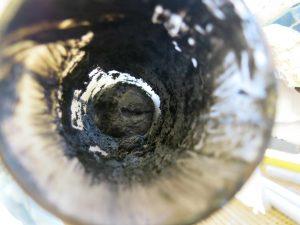

The core catcher functions as the bottom plug of every core; it has moveable metal teeth that fold out during core recovery and hold the entire sediment or rock core in place before it can slide back under its own weight. By capturing the bottom bits of each core, the core catcher always contains the deepest material that is recovered during each drilling step, and provides a preview of what is about to come up in the next core. This small shiny piece of rock pictured on the side means that now we are really up to something.
The next core is coming up after dark and the catwalk gets very busy. Here, the core catcher is handed over by the drill crew; they know how difficult it is to drill into rock without breaking it to pieces, they know that this core will be good, and they are clearly proud of their work!
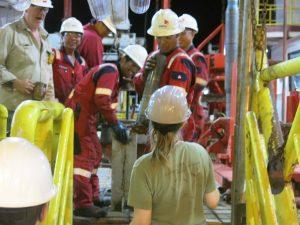
The core catcher that comes up together with the shout-inducing core contains another beautiful sample that continues the rock core downwards and dispels any doubt — we are within the sill. Here, technician Susan Boehm, Tobias, geochemist Ji-hoon Kim and Ligia Pérez Cruz are admiring the evidence and pronounce, “It’s a sill!”
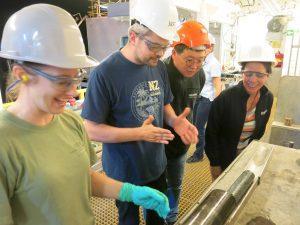
The core is broken in a few places, but otherwise nicely intact. The individual pieces fit each other so well that many can be glued together for scanning and imaging, of course with a special rock glue. Good recovery can never be taken for granted; many rock drills recover only shattered bits and pieces. Up close, the rock looks like an Italian terrazzo floor of large, bright crystals embedded into a darker host rock; the crystals originate from slow cooling of magma.
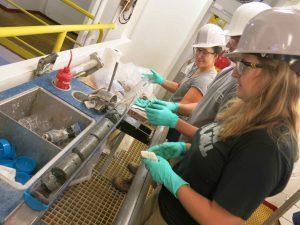
We are so impressed with the high quality of this core that two more hours are spent on one more go at this site, to sample the sill even more deeply. The second sill sample is even better: a smooth column of rock, chiseled out with delicate care 358 meters below the seafloor. This sill is no longer glowing hot as when it was emplaced several hundred thousand years ago; since then it has cooled down to the temperature of the ambient sediment column and is in thermal equilibrium with its environment. But the chemical and microbial traces of this intrusion event are still there and remain to be traced in the sediment column; this is the heart of the scientific mission for this site.

The historic sill recovery is carried out and witnessed by the X-Men night shift: Underway technician Dan Marone, lab officer Lisa Crowder, technician Jasmine Baloch, X-Ray technician Mackenzie Schoemann, assistant lab officer Beth Novak, and technician Susan Boehm.
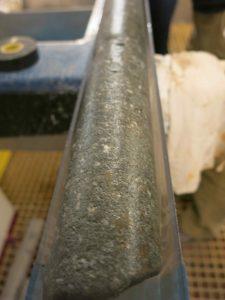
It would have been tempting to continue, but next we have a microbiology hole, and the microbiology shift is waiting and can tackle more cores after processing the overload from the previous site. We declare “End of Hole” and the JR moves 20 meters east to begin the next hole at this site.
The sill cores are set aside for description, but everything has to be done in proper order and jumping ahead is not permitted. The core description team is steadily making progress towards deeper and deeper sediments and will finally catch up.
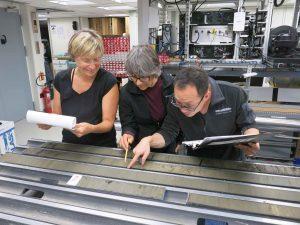
Here, Martine Buatier, Joann Stock and Wei Xei, from Hohai University in Nanjing, China, are looking for hydrothermal alteration signatures in a core midway down the sediment column, near the topmost reach of hydrothermal fluids that have bubbled up at the time when the hot sill intruded into the sediment column. They all wear the latest fashionable JR color: hydrothermal metal sulfide black. Diatom Olive Green of Site 1545 is so passé…
This blog post first appeared on Oct. 7 on my daily blog of EXP385. Make sure to go to expedition385.wordpress.com to read the latest updates of this expedition!